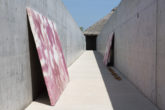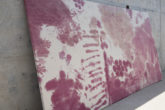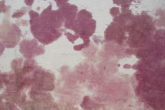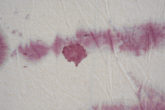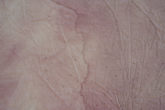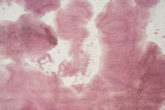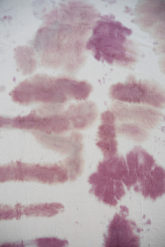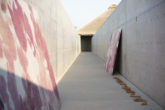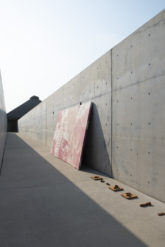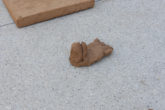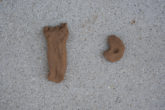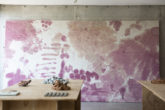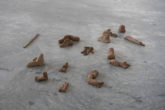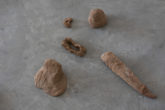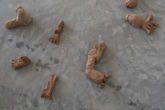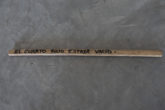« Dreamers Dream Dreams—Red Room »
14 teenagers studying at Escuela Telesecundaria in El Venado, Oaxaca, Mexico, and I—we met in our dreams, in a red room.
The dreams in which we saw each other are neither mine nor yours.
The red room wherein we both dreamt now belongs to you and me—the shared dreams became ours.
With our eyes closed, we always find each other in that room.
Is it slightly confusing to keep dreaming outside that room, with our eyes wide open?
Your eyes might well say that I look rather different from how I looked in your dreams, from what you have sculpted blindfolded.
At times you might see the world in disguise.
But your hands clearly know that I am your clay.
And our red room will remain lucid in shifting light—
Megumi Matsubara
Puerto Escondido, April 2019
« Soñadores Sueñan Sueños—Cuarto Rojo / Dreamers Dream Dreams—Red Room »
« Cuarto Rojo #1 / Red Room #1 » « Cuarto Rojo #2 / Red Room #2 »
Hibiscus pigment on cotton over plywood
Dimensions: 230×440 framed, 256×464 fabric (cm)
« El cuarto rojo estaba vacio / The red room was empty »
Ceramic installation composed of 15 sets of objects & palm tree wood
Dimensions: 161×132 overall installation size (cm)
Year:
2019
Artists:
Jazmín Esmeralda Torrez
Yesenia López Salinas
Miguel Velasco Barrios
Narmi Marlen Velasco Barrios
Brisa Coral Salinas López
Alondra Jazmín Jiménez Jiménez
Pedro Ríos Barrios
Adolfo Manuel Ríos Torres
Diego Armando Castro Miguel
Betzaida Ríos Gopar
Roberto Barranco López
Anel Carina Díaz Ríos
Jared Díaz Rodríguez
Karla Lilet Cuevas Santiago
&
Megumi Matsubara
* This project was developed by the artist in response to the invitation by Fundación Casa Wabi to the residency program; March – April 2019.
« Cuarto Rojo #1 / Red Room #1 »
« El cuarto rojo estaba vacio / The red room was empty »
© Collection of Fundación Casa Wabi
« Cuarto Rojo #2 / Red Room #2 »
© Courtesy of the artist
Program coordination:
Juan Pino
Gustavo Parra Alvarado
Project conception:
Megumi Matsubara
With invitation and support by:
Fundación Casa Wabi & Team of Casa Wabi
With special thanks to:
Escuela Telesecundaria
Felipe’s Pottery Kiln
—
MEMOIR
Monday, April 1, El Venado. The Tale of the Japanese and the Garden.
In the car to Escuela Telesecundaria, one question still remains: Where will I hide myself? I should not be seen by the students—we should not meet in the visual world.
On our arrival at the school, this quickly resolves. In their yard, an abandoned shed stands at a perfect distance from the school’s main building. We get off the car. I observe the direction of the sun, choose two areas to spread the sheets of fabric, then walk straight into the shed. Today, the rest must be carried out without me. I’ve already asked Juan and Gustavo to first read my book, The Tale of the Japanese and the Garden (translated into Spanish by Gustavo), to the students. The students will meet me in the story. They will see me in their minds.
Shortly after the story reading, they will be guided to the shades where fabrics are. They will be asked to capture the light falling through trees, and to paint it with the red flower petals I prepared. I’ve chosen hibiscus to depict the spectrum of our red. I’ve learnt various shades of its red while keenly experimenting the flower’s pigment in the past week. Hibiscus water that Emilia prepares for us, whose vivid red is like fresh blood, has inspired me to study this pigment.
The sequence of instructions from ‘invisible’ me, via Juan and Gustavo, suggests the students to see the morning light in hibiscus red, under their palm trees.
« On a continent far west from Japan, there was a city forgotten by the rest of the world; a beautiful city, more than one thousand years old. On the west end of this city, there was a beautiful palace, forgotten by everybody. The palace was more than one hundred years old, brightly decorated. However, being forgotten, the building was slowly ruining, unable to maintain its original condition.
In the palace, there lived a family who tried to take care of the once grand place. The palace had countless rooms all decorated in a myriad of colours. But the most beautiful were the three rooms coloured by light; one red, another blue, and the other green. Only when the sunlight shined in did these rooms show their colours. Each room was called by its colour.
In the palace, there also lived a Japanese who was forgotten by her own country. One day in autumn, she arrived without notice, asking the family if she could pass a night in their red room. The Japanese said that she had dreamt about their red room, and had come to visit… »*
*Extracts, The Tale of the Japanese and the Garden
❋
April 3, El Venado. Red Room.
Another day of hiding—not seeing. This time, however, the students and myself will be in the same room. My hiding shed has transformed itself into a red room—I spread our hibiscus-red fabrics to entirely cover its floor. I will be ‘sleeping’ in that room, while the students will be guided blindfold therein. Again, we will not ‘see’ each other. But they will know me in their touch.
Gustavo puts bandanas to blindfold the students and tells them that they will enter a room where some creature is sleeping. In that room, with a few ropes as guidance, each of them explores a different part of its (my) body through touch. All they are asked to do is to touch without looking, and memorise this contact.
Upon sensing their entering the room, I hear giggles. The noise is soon replaced by silence as their hands begin to take all their attention. On my skin, their touch feels like that of insects’. Their fingers cautiously knock the surface of my body. They investigate the invisible volume. They eventually exit the room still blindfold, and are each given a piece of clay. With the clay, they are asked to form what they have memorised through their hands. Yes, all this with the blindfolds covering their eyes.
Now the students have begun forming clay outside, I open my eyes and sneak out of the shed. I quickly take a look at the clay objects they are forming. In mere fifteen minutes, they declare they have finished. They want to make their ways out of the blindfolds.
I hide myself in the car. The students return to the world of eyesight. They look at the objects they have formed with clay. Then they are guided back to the shed where they explored the sleeping body through touch. In the shed, they recognise the fabrics on the floor, even if its red colour has turned slightly pale. Their eyes also witness that the room is now empty, as if what they touched in that room never existed.
The students of Escuela Telesecundaria—they have been developing their perception over the years through various community projects run by a variety of artists who worked with Casa Wabi. That is what Juan and Gustavo told me. I believe so. It is evident in the students’ approach: they tackle any given situations with their maximized sensitivity.
The students have finally gone home. I take a close look at the clay objects. Gustavo tells me which body part each object represents. The students would not form anything alike if they prioritise their eyes. None of them would sculpt me in this manner, if they allow their eyes to guide them.
Without hesitation, I decide to bring the objects to Felipe’s kiln. They resonate. They need to be fired. This ‘imagined body’ shall be kept intact.
❋
April 5, El Venado. Our Tales.
The students spend rather quiet time this morning, compared to two other mornings in the previous days. I asked Juan to hand them paper and pen, and play a collective-story-writing game. One writes a sentence, then another writes a following sentence, then another… until the story somehow ends. Simple game. The only rule is to not see the entire story but just the prior sentence written by another person, and add your own line that makes sense. Then at the end of the game, they all read the whole story together.
In fact, the rule of this game sounds like the process of this project between the students and myself. Or even Casa Wabi and myself. And Mexico and myself.
When I am writing a story, am I a writer or a reader of the story? While writing a new story, aren’t I reading and writing at the same time?
Juan has gathered three short stories from the students, and handed them to me after this session. He says they made six out of which only three make sense to him. I was there present with them, but again hidden. The students must be now used to having me around unseen. In fact, Juan says that they are curious about the shadow of a stranger who sometimes walks across their yard. However, he also says that they easily forget about me. Some of the students believe they have touched an unknown animal in the previous session, not even associating the body to a human being. I wonder what kind of animal they picture in their minds. Deprived of sight, are we more free? Can I actually become anything they want me to be?
My story, The Tale of the Japanese and the Garden, shared to them on the first day, is returned to me in altered versions. Now in their own and new narration, the story ends with: « Así que vivieron felices y contentos en su hermoso jardín. / So they lived happily and happily in their beautiful garden. » In their statement, no matter what, we share a beautiful garden and live ever happily together therein. If that’s what they dream, and what we dream, the next step is—“How?”
❋
April 8, Casa Wabi. Dreamers Dream Dreams.
Monday again. Within the course of one week, the students of Escuela Telesecundaria and I established three ‘meetings,’ before the fourth. But this fourth meeting will be the first time we become visible and are officially introduced to each other.
Upon the students’ arrival at Casa Wabi at ten o’clock in the morning, I cannot help smiling. I stand in front of them and express how happy I am to welcome them. But I don’t forget to ask one question, “Do you know me?” I see them turning their heads sideways, smiling in confusion. With a small sense of hesitation, they answer, “No.”
I smile even bigger, and ask them to follow me to the corridor in front of the main gallery space. Over the weekend, I framed our hibiscus-red paintings on plywood panels with Juan-Eloy, fired the imagined-body clay pieces at Felipe’s atelier to complete them as sculptures, and installed the finished work there.
I ask the students to look at the paintings and the sculptures. We take a long time looking at the works and talking about them: our first verbal conversation. Also prepared is a symposium among us in the cinema room. The full photo documentation of our three ‘meetings’ in the previous week is projected on the screen. They see for the first time our ‘invisible’ process of exchange through their eyes. Reflecting upon the complex project and what we have experienced together, we exchange words.
At the end of our symposium, I ask them if we can present our project to the public from that day forth. They agree. They say the title I propose « Soñadores Sueñan Sueños / Dreamers Dream Dreams » is perfecto. A new shared entity emerges—a space in which we together dream. May we call it « Cuarto Rojo / Red Room »? And I promise to stay in that room, for a very long time—
Before goodbye, they give me hugs. We look into each other’s eyes with a sense of intimacy. I confirm in their eyes that they know me more than they think they do, and we share more than they think we do.
If the students and I desire to dream together in this context, it is my honour to crystalize the dreams and celebrate our shared entity appearing in our sight.
In truth, didn’t I, didn’t we, collaborate with invisible beings through our bodies? The students’ bodies clearly carry the memory of the unbroken commitment between Escuela Telesecundaria and Casa Wabi, and every project they shared in the past. I touched all such memories through their bodies. We dreamers became a single organism forming a body of work that wouldn’t have existed otherwise.
Here—I claim our new entity « Cuarto Rojo / Red Room », and call for celebration.
—
Public activities:
Project « Soñadores Sueñan Sueños—Cuarto Rojo / Dreamers Dream Dreams—Red Room »
– 3 sessions at Escuela Telesecundaria with 14 students, Apr 1, Apr 3, Apr 5
– 1 session at Casa Wabi with the Escuela Telesecundaria students / Vernissage & Symposium, Apr 8
– Exhibition of the resulting work at Casa Wabi, Apr 8 & onwards
Reception of the Japan Foundation visit at Casa Wabi, Apr 15 -16
Acknowledgements:
For my stay at Casa Wabi, I would like to deeply thank to
Alberto Ríos de la Rosa, for our encounter in Copenhagen followed by the introduction to Casa Wabi
Paola Jasso, for her warm welcome in Mexico and our continuous dialogue
Carla Sodi, for her warm welcome at Casa Wabi and vigilant care for my stay and my practice
Patricio Sodi, for his warm-hearted care and tenderness with us artists at Casa Wabi
Bosco Sodi, for sharing his big love by conceiving Casa Wabi which continues to expand
Juan Pino, for his firm commitment and integrity in understanding and conducting projects together
Gustavo Parra Alvarado, for his conscious and considerate cooperation achieving enormous synergy
Emmanuel Leyva César, for his keen advices and active support especially in preparation of clay
Juan-Eloy, for his exceptional gentleness and never-ceasing support for my work and our well-being
Cherry, for her earnest hard-work in keeping our living environment always very happy
Emilia, Jassi, Susa, for their heart-warming home food that kept nurturing me and my knowledge
Felipe’s pottery atelier, for their efficiency and kind-hearted support in completing sculptures
Artists who stayed together at Casa Wabi, for the friendship and support we have grown throughout
Students and Teachers from Escuela Telesecundaria, for their trust in sharing experiences with me
Shuhei Yoshimura & Ileana Rojas of Fundación Japón en México, for their commitment to exchange and visiting me at Casa Wabi
&
Every individual whom I encountered at Casa Wabi, listed or unlisted here, for their kindness and knowledge that were open-handedly given to me
—
Megumi Matsubara
Memoir of Casa Wabi, dépôt: 29 April 2019
*To request the full PDF version of this memoir accompanied by images, email <tokyo@withassistant.net> mentioning your name and purpose of your research.

